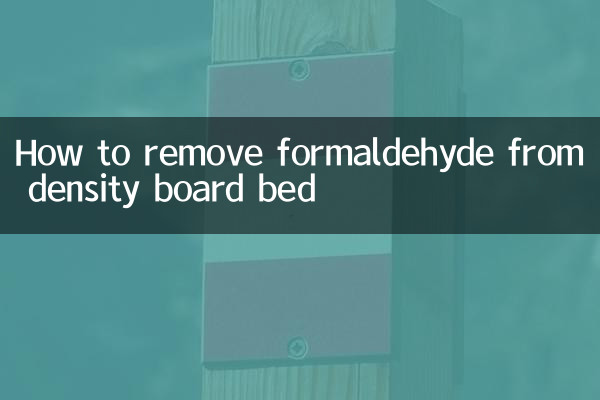How to remove formaldehyde from density board bed
In recent years, with the popularity of home decoration, density board furniture has been favored by many consumers because of its low price and diverse shapes. However, the adhesive used in the production process of density board releases formaldehyde, posing a potential threat to human health. Especially for beds made of density boards, the formaldehyde problem needs to be paid more attention to due to the longer contact time with people. This article will combine the hot topics and hot content on the Internet in the past 10 days to provide you with a detailed analysis of how to effectively remove formaldehyde from density board beds.
1. The hazards of formaldehyde and the formaldehyde release characteristics of density board beds

Formaldehyde is a colorless gas with a pungent odor. Long-term exposure may cause respiratory diseases, skin allergies, and even induce leukemia. The formaldehyde release cycle of density board beds is relatively long, usually 3-15 years, and the amount of formaldehyde released will intensify especially in high temperature and high humidity environments. The following are the characteristics of formaldehyde release from density board beds:
| Features | Description |
|---|---|
| Long release cycle | The period ranges from 3 to 15 years, and the early release volume is relatively large. |
| Affected by environment | The higher the temperature and humidity, the greater the release amount |
| High initial concentration | Newly purchased density board beds have the highest formaldehyde emissions |
2. Effective method to remove formaldehyde from density board bed
According to popular discussions on the Internet in the past 10 days, the following are several widely recognized methods for removing formaldehyde from density board beds:
| method | Operating Instructions | Effect |
|---|---|---|
| ventilation method | Keep the room well ventilated, especially during the first 3 months after purchasing a new bed | The effect is significant, but it requires long-term persistence |
| Activated carbon adsorption | Place activated carbon packs around the bed and replace them regularly | The short-term effect is better, but it needs to be combined with other methods |
| Photocatalyst technology | Use professional photocatalyst spray to treat bed surface | Effective for a long time, but requires professional operation |
| air purifier | Choose an air purifier with formaldehyde filtration | Continuously effective, but the filter element needs to be replaced regularly |
| Green plants absorb | Place plants with formaldehyde absorption capabilities such as spider plants and pothos. | Auxiliary effect, limited effect |
3. Precautions for formaldehyde removal
In the process of removing formaldehyde from density board beds, you need to pay attention to the following points:
1.Avoid sun exposure:Although high temperatures can accelerate the release of formaldehyde, exposure to the sun may cause cracking and deformation of density boards.
2.Use a combination of methods:A single method has limited effect. It is recommended to combine ventilation, adsorption, purification and other methods.
3.Detect formaldehyde concentration:You can use a formaldehyde detector to monitor regularly to ensure that the formaldehyde content is within a safe range (≤0.08mg/m³).
4.Pay attention to the children's room:Children are more sensitive to formaldehyde, so you need to pay special attention to density board beds in children's rooms.
4. Evaluation of popular formaldehyde removal products
According to recent e-commerce platform sales data and user reviews, the following are several popular formaldehyde removal products:
| Product name | Type | average rating | reference price |
|---|---|---|---|
| XX brand formaldehyde scavenger | chemical decomposition | 4.7/5 | ¥129 |
| YY air purifier | Physical filtering | 4.8/5 | ¥899 |
| ZZ activated carbon bag | adsorption type | 4.5/5 | ¥39.9 |
5. Expert advice
1. The China Indoor Environment Monitoring Committee recommends that newly purchased density board furniture should be ventilated for at least 3 months before use.
2. Research from the School of Environment of Tsinghua University shows that for every 5°C increase in temperature, the amount of formaldehyde released increases by about 1.5 times. Special attention should be paid in summer.
3. Professor Wang, a home decoration expert, suggests: If the budget allows, give priority to E0 or ENF grade environmentally friendly density boards.
Conclusion:
Removing formaldehyde from density board beds is a process that requires patience and scientific methods. With proper ventilation, the use of professional products and regular testing, it is possible to create a safe home environment. I hope the information provided in this article can help you effectively solve the formaldehyde problem in density board beds and protect the health of your family.

check the details

check the details